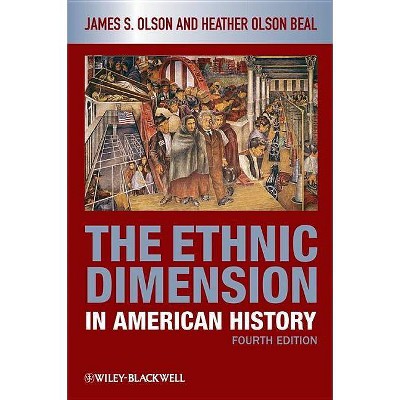Ethnic Dimension in American H - 4th Edition by Heather Olson Beal & James S Olson (Paperback)

Similar Products
Products of same category from the store
AllProduct info
<p/><br></br><p><b> Book Synopsis </b></p></br></br><i>The Ethnic Dimension in American History</i> is a thorough survey of the role that ethnicity has played in shaping the history of the United States. Considering ethnicity in terms of race, language, religion and national origin, this important text examines its effects on social relations, public policy and economic development. <ul> <li> A thorough survey of the role that ethnicity has played in shaping the history of the United States, including the effects of ethnicity on social relations, public policy and economic development </li> <li> Includes histories of a wide range of ethnic groups including African Americans, Native Americans, Jews, Chinese, Europeans, Japanese, Muslims, Koreans, and Latinos </li> <li> Examines the interaction of ethnic groups with one another and the dynamic processes of acculturation, modernization, and assimilation; as well as the history of immigration </li> <li> Revised and updated material in the fourth edition reflects current thinking and recent history, bringing the story up to the present and including the impact of 9/11 </li> </ul><p/><br></br><p><b> From the Back Cover </b></p></br></br><i>The Ethnic Dimension in American History</i> is a thorough survey of the role that ethnicity has played in shaping the history of the United States. Considering ethnicity in the sense of race, language, religion, and national origin, this important textbook examines the effects of ethnicity on social relations, public policy, and economic development. Ethnic groups covered in the book include African Americans, Native Americans, and Americans of varied backgrounds from across the globe including Jewish, Chinese, European, Japanese, Muslim, Korean, and Latinos.<br/> <br/> Examining the period from the first Americans before colonization to the present day, the fourth edition of <i>The Ethnic Dimension in American History</i> has been thoroughly revised and updated to reflect current thinking and recent history, including the impact of 9/11. This book presents ethnicity as a central dynamic in US history. It is not just concerned with the history of immigration, but considers the interaction of ethnic groups with one another, and describes the dynamic processes of acculturation, modernization, and assimilation, which have had such a great impact on the United States throughout its history.<p/><br></br><p><b> About the Author </b></p></br></br><p><b>James S. Olson</b> is Distinguished Professor of History at Sam Houston State University, Texas, where he has been honored with the university's Excellence in Teaching and Excellence in Research Awards. He is the author, co-author, editor or co-editor of over 30 books. His book <i>Bathsheba's Breast: Women, Cancer, and History</i> (2002) won the History of Science Category Award from the Association of American Publishers and was recognized by the Los Angeles Times as one of the best non-fiction books in America for 2002.</p> <p><b>Heather Olson Beal</b> is Assistant Professor of Secondary Education and Educational Leadership at Stephen F. Austin State University in Nacogdoches, Texas.</p>
Price History
Price Archive shows prices from various stores, lets you see history and find the cheapest. There is no actual sale on the website. For all support, inquiry and suggestion messagescommunication@pricearchive.us




















